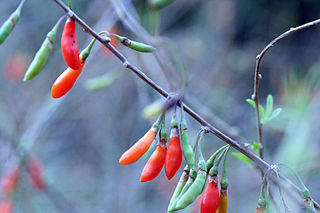
Goji, goji berry, or wolfberry is the sweet fruit of either Lycium barbarum or Lycium chinense, two closely related species of boxthorn in the nightshade family, Solanaceae. L. barbarum and L. chinense fruits are similar but can be distinguished by differences in taste and sugar content.

Lycium is a genus of flowering plants in the nightshade family, Solanaceae. The genus has a disjunct distribution around the globe, with species occurring on most continents in temperate and subtropical regions. South America has the most species, followed by North America and southern Africa. There are several scattered across Europe and Asia, and one is native to Australia. Common English names for plants of this genus include box-thorn, wolfberry, and desert-thorn. There are about 70 to 80 species.

Physalis peruviana is a species of plant in the nightshade family (Solanaceae) native to Chile and Peru. Within that region, it is called aguaymanto, uvilla or uchuva, in addition to numerous indigenous and regional names. In English, its common names include Cape gooseberry, goldenberry and Peruvian groundcherry.

Carissa is a genus of shrubs or small trees native to tropical and subtropical regions of Africa, Australia and Asia. Until recently about 100 species were listed, but most of them have been relegated to the status of synonyms or assigned to other genera, such as Acokanthera.

Lycium barbarum is a shrub native to China, with present-day range across Asia and southeast Europe. It is one of two species of boxthorn in the family Solanaceae from which the goji berry or wolfberry is harvested, the other being Lycium chinense.

Solanum nigrum, the European black nightshade or simply black nightshade or blackberry nightshade, is a species of flowering plant in the family Solanaceae, native to Eurasia and introduced in the Americas, Australasia, and South Africa. Ripe berries and cooked leaves of edible strains are used as food in some locales, and plant parts are used as a traditional medicine. Some other species may also be referred to as "black nightshade".

Lycium chinense is one of two species of boxthorn shrub in the family Solanaceae. Along with Lycium barbarum, it produces the goji berry ("wolfberry"). Two varieties are recognized, L. chinense var. chinense and L. chinense var. potaninii. It is also known as Chinese boxthorn, Chinese matrimony-vine, Chinese teaplant, Chinese wolfberry, wolfberry, and Chinese desert-thorn.

Cestrum nocturnum, the lady of the night, night-blooming jasmine, night-blooming jessamine, night-scented jessamine, night-scented cestrum or poisonberry, is a species of plant in the potato family Solanaceae. It is native to the West Indies, but naturalized in South Asia.
Christmasberry can refer to any one of several shrubs or small trees, as well as their colorful fruit:

Rhus trilobata is a shrub in the sumac genus (Rhus) with the common names skunkbush sumac, sourberry, skunkbush, and three-leaf sumac. It is native to the western half of Canada and the Western United States, from the Great Plains to California and south through Arizona extending into northern Mexico. It can be found from deserts to mountain peaks up to about 7,000 feet (2,100 m) in elevation.

Lycium andersonii is a species of flowering plant in the nightshade family, Solanaceae. Its common names include water-jacket, redberry desert-thorn, Anderson thornbush, Anderson's desert thorn, Anderson boxthorn, Anderson lycium, Anderson wolfberry, and squawberry.

Lycium ferocissimum, the African boxthorn or boxthorn, is a shrub in the nightshade family (Solanaceae) indigenous to South Africa.

Lycium fremontii is a species of flowering plant in the nightshade family, Solanaceae, that is native to northwestern Mexico and the southernmost mountains and deserts of California and Arizona in the United States. It often grows in areas with alkaline soils, such as alkali flats.

Rhamnus lycioides, the black hawthorn, European buckthorn, or Mediterranean buckthorn, is a shrub up to about 1 metre tall in the buckthorn family, Rhamnaceae. It is found in the Mediterranean region, in southern Europe and northern Africa. Its scientific name lycioides refers to its resemblance to the botanical genus Lycium.

The Solanaceae, or the nightshades, are a family of flowering plants that ranges from annual and perennial herbs to vines, lianas, epiphytes, shrubs, and trees, and includes a number of agricultural crops, medicinal plants, spices, weeds, and ornamentals. Many members of the family contain potent alkaloids, and some are highly toxic, but many—including tomatoes, potatoes, eggplant, bell and chili peppers—are used as food. The family belongs to the order Solanales, in the asterid group and class Magnoliopsida (dicotyledons). The Solanaceae consists of about 98 genera and some 2,700 species, with a great diversity of habitats, morphology and ecology.

Lycium oxycarpum is a shrub in the nightshade family (Solanaceae) indigenous to the Karoo regions of South Africa.

Lycium horridum is a shrub in the nightshade family (Solanaceae) indigenous to South Africa as well as southern Namibia and Botswana.
Lycium pumilum is a shrub in the nightshade family (Solanaceae) indigenous to South Africa and Namibia.
Lycium cinereum is a shrub in the nightshade family (Solanaceae) indigenous to southern Africa. It is widespread across South Africa, as well as southern Namibia and Botswana.
Lycium tenue is a shrub in the nightshade family (Solanaceae) indigenous to South Africa.

















